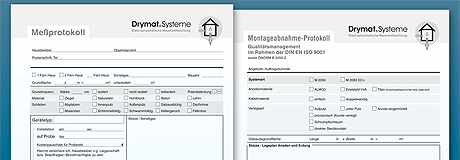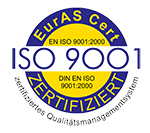
Maximum chance to succeed, minimal risk – where else is there such a thing in wall drying?
Damp walls in buildings pose a serious problem: moist damages the building structure in the long term and deprecates the quality of life. As a proven and scientifically recognized process according to Ö-Norm 3355, electro-physical wall dehumidification enables basement drying without high costs or much effort and, in the long term, allows for dry walls in the entire house.
The electro-physical method of dehumidifying walls by introducing electrodes into them* is a scientifically recognized and highly effective procedure that is risk-free for humans and the building structure. You can best learn how it works by consulting our video on the right.

Moisture barriers are often completely absent from old buildings, whereas built-in horizontal barriers may lose their effectiveness over time. The result is rising moisture, which firstly causes damage to the groundwork in the basement respectively, and eventually to the building structure along the entire wall. An indication of a missing sealing is a wet basement floor or an entirely wet basement as well as salt efflorescence.
The salts leaching out from the soil penetrate into the walls and increase the conductivity of the water. This creates a measurable negative potential within the walls. The effective capillary forces as well as the effect of the salts make sure that the water is constantly ascending the walls. Conventional methods of wall dehumidification and sealing are, as a rule, cumbersome and expensive. In many cases, the measures only work for a few years before the problem of damp walls arises again.
The Drymat wall dehumidification addresses the “evil” directly at the root. The sealing layer is installed exactly where it is called for, namely beneath the house. And this requires only a minimal interference with the structure. The process of wall dehumidification begins with a thorough analysis of the actual condition with the aid of humidity measurement. Subsequently, several electrodes are introduced into the walls to generate electric field in the latter. As a result, free water molecules are positively charged and thus attracted by the earth acting as a negative potential – instead of migrating further up the walls, the molecules go back to the ground. How this proven and Ö-Norm 3355–certified principle works, see in our video above.
This damage-free and comparatively inexpensive method of wall dehumidification draws upon potential shift in the structure. The polarity of the electric field in the walls is reversed, the salts as charge carriers make a turn, the moisture is hereby caused to change its direction, and the the walls dry out. At the same time, the walls are actively desalinated, so that the cause of the process is eliminated. Another side effect of electro-physical wall dehumidification is the release of atomic oxygen, which in turn can suppress the growth of algae, bacteria, and dreadful mould fungi.
Due to the combination of dehumidification and desalination of the walls has a sustainable effect compared to other wall drying methods. By contrast with pure basement wall sealing, the hygroscopically active salt is removed from the walls, so that no new moisture is absorbed from the air.
The time to a complete wall dehumidification with Drymat is one to two years depending on the wall thickness and actual condition. Already in a relatively short term the surfaces dry out, and at the end of the drying process the wall is dehumidified up to the core. After one year, first control measurements are carried out to document the progress.
The Drymat System is individually adjusted to the specific circumstances and requirements of each drying task, and the drying process is constantly monitored and readjusted as needed. At a small extra charge, the process of dehumidification and desalination can be monitored as well by the TÜV (technical monitoring association) or a state-accredited construction materials test laboratory.
Euras Cert ISO 9100 Drymat®Systeme. This way, we usually conduct one drying in 3 to 12 months – so, a comfortable living environment returns, and the heating costs reduce by up to 65%. The Drymat®System as well as all processes and procedures are certified according to Euras Cert ISO 9001.
You can find detailed information about ÖNORM 3355 here: ÖNORM 3355.
If you want to have your basement dry for a long term, we would be glad to receive your message or call and arrange a first consulting appointment.
In the run-up to the dehumidification of damp walls, a lot of questions arise for building owners. Here you can find some answers: